603 Search Results for tell me about it
April 12, 2013
by Carole Zangari -
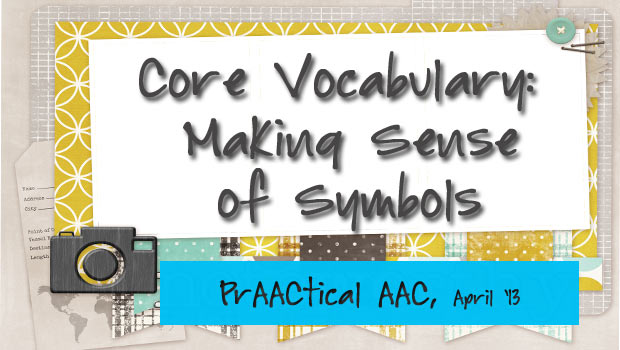
Take a look at these pictures and try to guess their meanings. Now do it again with these symbols. One more time with the symbols below. We’re not gamblers by nature, but if we had to bet we’d say that you had a pretty easy time guessing the first two rows (backpack, banana, bathroom; sleep, wash, eat) and struggled with the last row (know, she, was/were). That presents a bit of a problem, actually, because it’s that last hard-to-guess row that contains important core vocabulary. And these kinds of core words are the ones we need to use frequently during the day. Looks like we have a bit of a dilemma: The symbols that are least transparent are important ones to teach. We often hear SLPs say that they want concrete symbols for some of their clients with AAC needs. We can certainly make that happen for some... [Read More...]
April 11, 2013
by Carole Zangari -
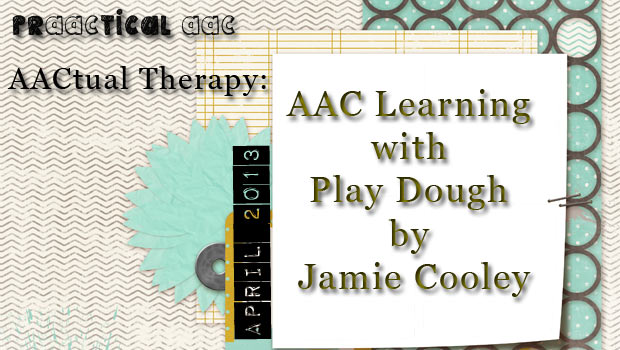
Today, we’re happy to introduce you to another AACtual Therapist, Jamie Cooley, the SLP for Belpre City Schools (belpre.k12.oh.us), located in Belpre, OH. She is a graduate of Ohio University (B.S. ’09, M.A. ’11) and currently resides in Athens, OH. Jamie did work at Ohio University focusing on AAC and children with autism under the instruction of Dr. John McCarthy and Dr. Joann Benigno. She has worked for Belpre City Schools for two years with students in grades K-12. In this post, Jamie uses a case study approach to share a lesson using Play Dough. Background Emma is a third grade student. She was born with hypoplastic left heart syndrome, and her cognitive and communication skills are significantly below age-norms. She receives most of her academic instruction in a resource room. Communicatively, Emma repeats many words and phrases, and combines up to two words on her own. This is... [Read More...]
April 9, 2013
by Robin Parker -
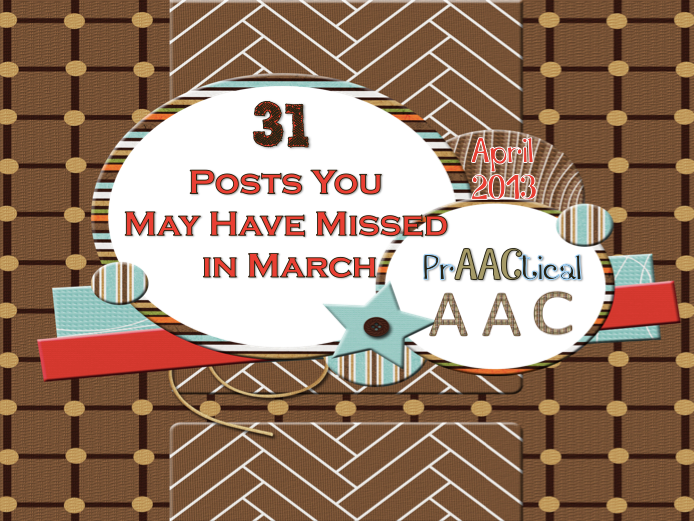
Strategy of The Month Narrative Skills for People with AAC Needs PrAACtical AAC & Personal Narratives Narrative Assessment & People Who Use AAC Let Me Tell You Something: Narratives for the Beginning Communicator Helping People with AAC Needs Develop Personal Narratives PrAACtical Thinking PrAACtical Guessing: 5 APPs for Interactive Inferencing Another Look at Vocabulary Instruction in AAC Magic Moments in Building Vocabulary with ‘Its Cool to be Clever’ It’s PrAACtically Saint Patrick’s Day 28 Posts You May Have Missed in February 10 AAC Things To Do for PrAACtically Free in 10 Minutes of Less Daylight Savings Time & PrAACtical Behavior Another Look At Language Facilitation Strategies to Make AAC Learning Effective Literacy, AT, & Students with Significant Disabilities Watch This: Planning with Strategies Worth Repeating: Big Ideas in Teaching AAC Vocabulary PrAACtical Passover & Easter Supports 30 Things to do During Autism Awareness Month A Beautiful Family, But 1 Question... [Read More...]
April 5, 2013
by Robin Parker -
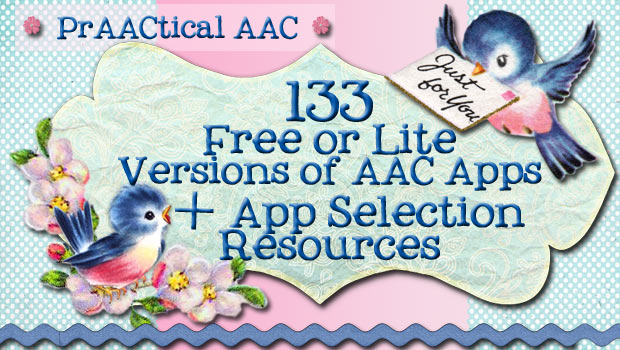
Here is our most recent update of free and lite versions of AAC apps for iOS and Android platform devices + a variety of resources related to AAC app selection. We strongly continue to advocate for a systematic process for AAC app selection. We recommend AAC app decision making in the context of a feature match process that gives appropriate attention to the full range of AAC options. Tools to Use In Making Decisions About AAC Apps Feature match form developed by Jessica Gosnell at Boston Children’s Hospital Feature match checklist created by Scott Marfilius and Kelly Fonner Our supplemental rubric covering language and communication features, RELAAACs Places to Go to Find AAC Apps and Reviews Comprehensive AAC app list for iPhone and iPad by Jane Farrall AAC Tech Connect’s Apps Assistant OCALI’s listing of apps for individuals with ASD Tech in Special Education Aidis Trust Communication App Reviews Training... [Read More...]
April 3, 2013
by Robin Parker -
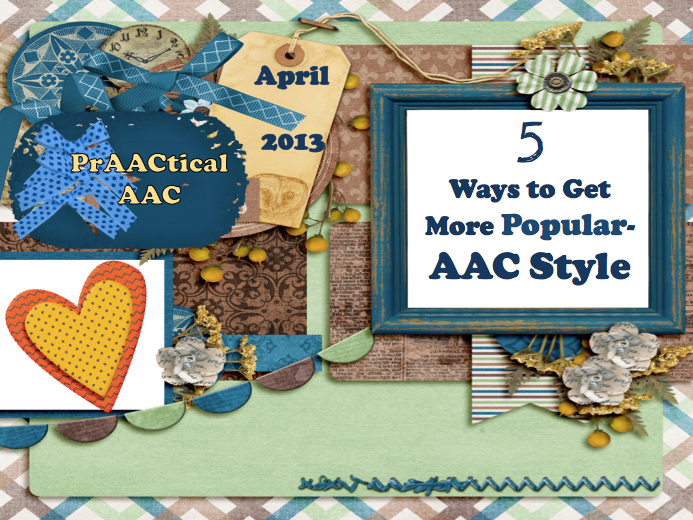
Popularity may or may not be important to children or adults, but most of us would like to have some friends and at least some people we can share information with. From a facilitator’s point of view, we need AAC users to have conversations with a variety of people. The more prAACtice in conversational exchanges the better. We have learned (through research and clinical experience) that if we teach specific skills, communication partners are more likely to initiate and respond to AAC communication. Here are things to teach for ‘conversational’ popularity 1. Teach Partner Focused Questions What’s up? How are you doing? How is your family? How are you feeling? What are you thinking? 2. Teach Social/Participation Scripts Attention Getters Starters Maintainers Turn Transfers Closings Let’s talk. Guess what? And next.. What’s your thoughts? That’s it. Come here. Let me tell you something. want a hint? Amazing right? See you later.... [Read More...]
April 2, 2013
by Robin Parker -
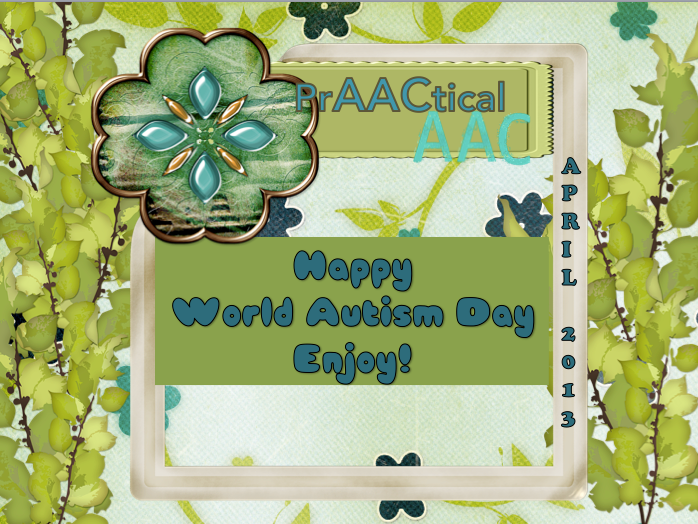
Enjoy! Voices of Autism- The SongStream Project explores the role of music in the lives of four young musicians on the autism spectrum. This project contributes to the conversation about autism beyond statistics and into the domain of appreciation and celebration. AAC Image Links (Great for training and education)- Speak for Yourself – Autism & AAC Awareness (bonus- enter to win Speak for Yourself AAC App) AAC Do’s & Dont’s by Lauren Enders AAC It’s Easy as 1,2,3 by Marcia Sterna World Autism Day Free or Discounted Apps- These are worth checking out! Look for more at the Appy Mall.
March 30, 2013
by Carole Zangari -
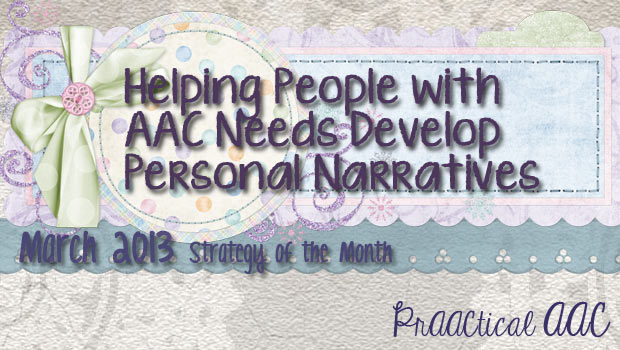
Where I come from, we value our independence. We look forward to the day when we can move out of our childhood homes into our first apartments. We’re intensely proud of our kids when they first do things on their own. We feel honored do to our first professional presentations or fly solo on a publication. We are driven to be independent in our professional and personal lives. Independence is all well and good, but sometimes we get caught up in thinking that it’s the most important thing for our clients who use AAC. Many times, it’s not. As SLPs well know, communication is a social act. Without the cooperation of another person, there is no communication.We need other people in order to communicate and we need them even more when we’re just learning. Independence is something, but it isn’t everything. For AAC learners, interdependence plays an important role. We love... [Read More...]
March 9, 2013
by Robin Parker -
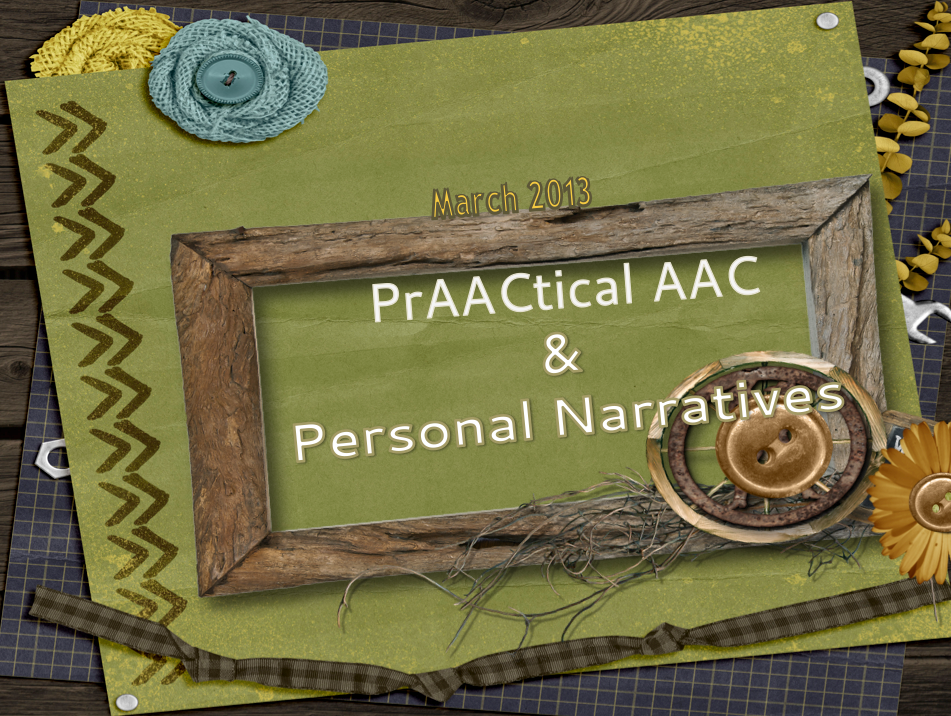
Personal narratives are the first story skills that develop. They tell about ourselves and our connection to activities, places, and events. They tell about how we feel about people and experiences. Personal narratives help us structure and organize the events of our lives and even become a way of thinking about ourselves and our identities. We know many AAC users have significant difficulty with narratives. We always wonder though, is it a function of language difficulty or of access, exposure, and PrAACtice or more likely a combination. There are key intervention strategies that help AAC learners be able to tell personal narratives. You probably won’t be surprised by what strategies work but the research from Gloria Soto and colleagues has shown us that when applied to personal narratives, AAC users can be competent story tellers. Some Thoughts on Personal Narrative Assessment Even before assessment of the AAC learner, in all fairness,... [Read More...]
March 8, 2013
by Robin Parker -
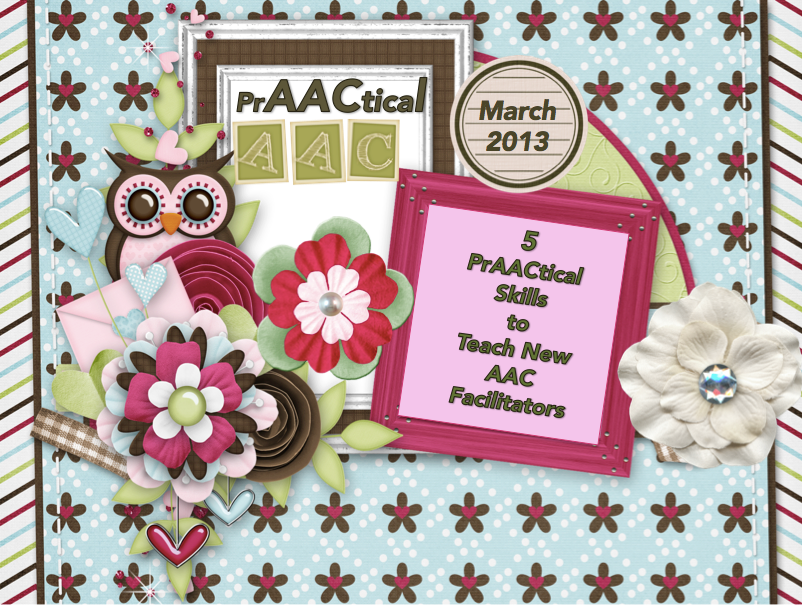
We have been out and about in our community these past couple of weeks. We have worked with speech-language pathologists, teachers, resource specialists, paraprofessionals, and families. We love doing AAC facilitator training because the impact is so important for not only our current AAC learners but for future AAC learners as well. There are really great professionals who want to provide the best AAC support possible. They want and need AAC information that will help them integrate AAC facilitation strategies into their already very busy days. Here are 5 AAC facilitation strategies that have made the most impact: Using Aided Language Input (ALI)– Talk AAC to the learner. This strategy is not only a very powerful teaching tool, but when discussed with new AAC facilitators, seems to make perfect sense (many have never heard of it). One key for learning ALI is to practice it in a variety of activities... [Read More...]
March 7, 2013
by Carole Zangari -
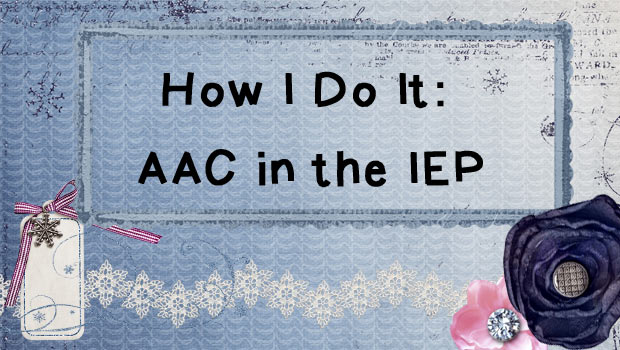
We’re happy to welcome back, Lauren Enders, an AAC specialist from Pennsylvania. You can read her earlier post here. This month, Lauren shares some of ways she addresses AAC learning in the IEP. Frequently, SLPs and teachers contact me in a complete panic because they need to generate an IEP and write IEP goals for a student who is using (or beginning to use) Augmentative and Alternative Communication (AAC). These folks have lots of questions and most often, have no idea where to begin. There are a number of questions that come up repeatedly in these panicked requests. When approached by PrAACtical AAC to write a post about IEPs and AAC, I thought it might be helpful to share some of the most common questions I hear along with the answers I provide. I will structure the post in a Question & Answer format in the hopes that the post... [Read More...]









